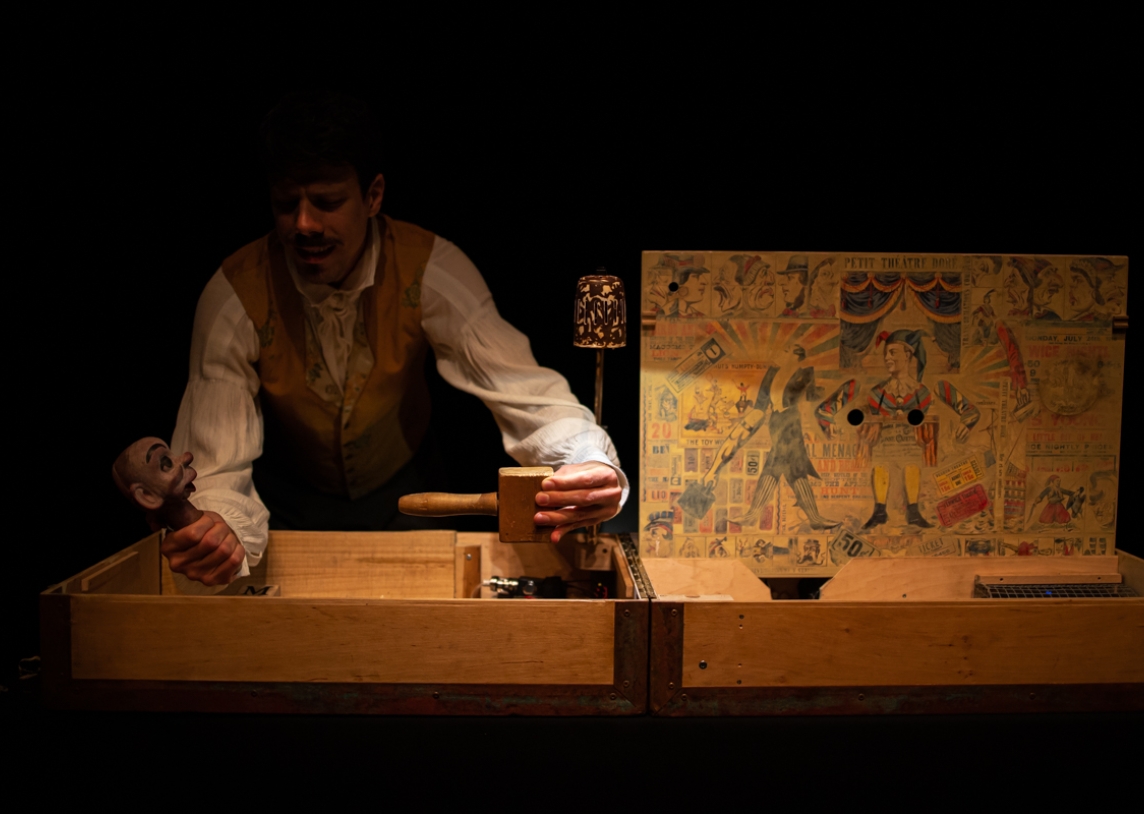- International Platform
- Content
Content
Wood into Flesh and Flesh into Wood. On Matteo Spiazzi's Pinocchio
Author: Tajda Lipicer
Geppetto brandishes his wood carving tool. His grandest creation is nearly complete. The Tuscan Prometheus puts a piece of his soul into the piece of wood. And, lo and behold, the piece of wood comes to life! Walking, jumping and talking, the piece of wood is precisely like a human—except that it isn’t. It is, however, alive. But it shows no respect. It doesn’t even say thank you to its creator. Also, it tends to lie. And lying must be punished, and the punishment must be exemplary.
The production was directed by the Italian director Matteo Spiazzi, who has already left his mark on Slovenia’s theatre of puppets and animated forms with a production of A Midsummer Night’s Dream (2015/16 season), is based on Carlo Collodi's late 19th-century didactic morality play. But rather than highlighting the absolutism of the hallowed creator, it chooses to explore what has perhaps so far been overlooked: the motif of Pinocchio’s transformation.
The production is informed by a grotesque atmosphere complemented by an almost clownish, burlesque tone, which the animator Miha Bezeljak helps create with his improvisation techniques, interactivity, and a breezily humorous, relaxed, and open-minded approach. Meanwhile, the episodes showing Pinocchio’s transformation into a donkey, and the delirious scene about death and the theatre of toys, where the appealing, spectacular splendour masks the exploitation of the performers, create a darker mood, thus shaking up the dynamic of the show. In the spiral, chaotic, episodic dramatic structure, Pinocchio’s transformation is a gradual process prompted by his own mistakes. With each episodic error of judgment, Pinocchio becomes a little less abstract and a little more figural, elaborate (puppet and set designer Primož Mihevc, puppet and set painter Darka Erdelji), until he becomes fully human. In the finale, Bezeljak tears off the costume (costume designer and maker Mojca Bernjak) that had hitherto characterised him either as Geppetto – being stylistically in line with the 19th-century fashion – or as a fictitious narrator. The transition is complete: before us is a nude human torso, the head marvelling at the wood-turned-skin, mistakes having differentiated a human from an automaton. This attenuates the 19th-century atmosphere of morality, lending a more positive aura to the production while taking away all Pinocchio’s morally dubious traits. Instead of being subjected to psychologisation, Spiazzi’s Pinocchio is an intriguing sociological phenomenon.
At first, Pinocchio is identified as an unworked piece of wood of no specific shape requiring a set of tools to turn it into a piece of flesh. By selecting the tools to carve the wood into puppets, or characters, the production doubles its illusionary and symbolic matrix, the narrative arc and the additional, partly meta-theatrical – in the narrow sense of puppet theatre – dimension merging into one. Before our eyes, the illusion both comes to life and reveals itself. As a product that erases the signs of its man-made origin, the aesthetic phenomenon moves away from its creator while the creation becomes a mystified window display item, a disguise to cover up the traces of a sinful, fallible human. In contrast, the emphasised DIY aesthetic of the production with puppets as “ready-made” objects unmasks the details of its making, thereby making a shift from the domain of traditional to contemporary puppetry while re-defining the moralistic tone of the original: the process is more important than the result, and it is precisely human mistakes that effect change.
The relationship between the animator and the puppet is part of this shift. Although the animation techniques include a mix of conventional methods of animating everyday objects, finger and hand puppets, thanks to the animator’s relationship, they are used in a more modern way. If, in the language of theatre semiotics, the everyday items used (an inkwell in the school scene or wood carving tools) are rather literal in terms of signs, in the context of the entire performance, they represent the substance of what the sign signifies rather than complement naturalistic representation.
The animator’s character is not entirely defined. He can identify as the animator, i.e. Miha Bezeljak, as a fictitious animator of the mobile theatre, as a fictional representation of the real author of Pinocchio, Carlo Collodi, or as Pinocchio’s father, Geppetto. As the rhythm of the production dictates, the matrix of the illusion may be amplified but never becomes fixed. The animator switches abruptly yet precisely between positions, depending on his relationship to animated objects, materials, and scenic elements. While lending them his speech apparatus, his actor’s presence serves as an acting partner to the objects and simultaneously pays regard to the interactive aspect of the show. This makes the whole piece open: instead of being hermetically limited to interactions with the objects, the animator extends the line of relationships to and among the audience. It is Bezeljak’s mastery of his speech apparatus or his inner vocal theatre that testifies most powerfully to his ability to step up intensity and density and shift between the layers of the play. In this context, speech techniques are more aesthetic than communication means, since verbal tools in a high-pitched, squeaky voice are not intended to be perceived rationally but sensorially.
At the 11th Biennial of Puppetry Artists of Slovenia, the production won the Award for Best Director.
This publication is written in the context of the project "European Contemporary Puppetry Critical Platform"

